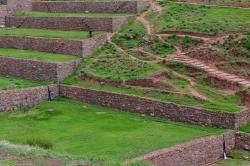
Tipon is a self-contained, walled settlement that served as an estate for Inca nobility. Located 13 miles down the Huatanay River Valley by the Inca capital of Cusco, the 500-acre archeological site provides knowledge and better understanding of the pre-historic Inca and their irrigation and building skills. The site represents great mastery of irrigation and hydraulic technology. The civil engineers of Tipon designed buildings, 13 integrated central terraces, waterworks, hundreds of other terraces and massive structures to be visually and functionally harmonious with their surroundings. These features have endured into the 21st century. Topographic surveying, clearing, structure measurements, mapping of three long unused canals, and analysis of how the Central Terraces were irrigated by their several canal systems have shown that the Inca engineers knew a lot about the handling and beneficial use of land and water for aesthetic purposes and community development.
Facts:
- The massive outer wall of Tipon, built before Inca times, is 15 to 20 feet high and nearly 4 miles long. The Inca converted the site to their own use.
- The Inca effectively utilized conjunctive use of surface water and groundwater.
- The Tipon site includes a 200-foot-long, masterfully designed and built aqueduct to carry surface water.
- The Tipon central terraces were designed to manage cold winter nights by conserving the sun's heat to ward off frost.
- Residences at the Tipon site accommodated about 500 people. Workers at Tipon were brought in from outside the walls.
- The Inca made good use of subsurface drainage techniques to ensure long-term integrity of the central terraces, which were built in a filled-in ravine.
- Special hydraulic structures were integrated into the Tipon terrace walls so that irrigation water could be lowered from one terrace to another. Some of the vertical hydraulic drops used by the Inca were 15-feet-high, but utilized design techniques that kept splash to a minimum.
- The Inca mastered the technique of bifurcation structures, effectively routing water in different directions to provide for efficient irrigation.
- Archaic petroglyphs that are many thousands of years old still exist on top of Tipon Mountain.


